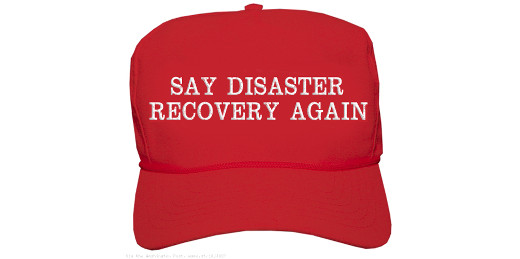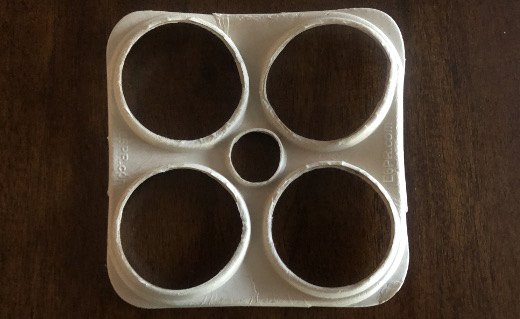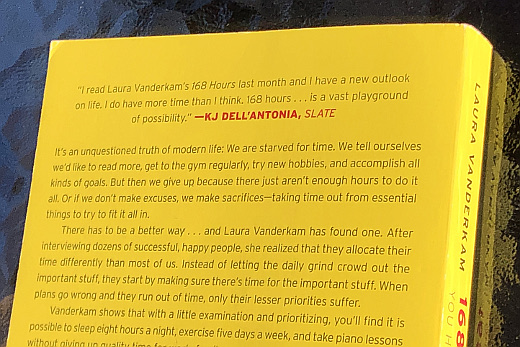What I Learned This Week for May 22 2020
In addition to learning that when someone says they have done all they can to solve a problem, and yet when pressed they come up with other things…
- Based on a recommendation, I watched the first 2 episodes of Upload on Amazon Prime and am stopping there. I am not sure if it was that I don’t think we’d have that kind of technology in 13 years or that I just didn’t like the characters. I now return to binge-watching Star Trek: Voyager.
- I am having a hard time with LinkedIn Messaging, where you can send messages to people thru the business social media platform. In some cases I get alerts when someone sends me a message, and other times I don’t. As a result, I have missed messages completely and have replied too late. As people tend to send more messages that way instead of email, something will have to give.
- Congrats to my friend and everyone involved with the launch of BostonExO, a consultancy centered around the ExO framework, which is short for exponential organizations.
- Apple has a trade-in program that has apparently been around for a while. Remember, this post is about what I learned.
- World HeadQuarters, a co-working space in Appleton, Wisconsin, is reopening on June 1. In the meantime, members with 24/7 access like myself can go back now. I have already taken a couple of meetings from there, and it’s good to be back.
- Western Tropic, an artisan card/board game, arrived in the mail this week. It was created by my friend Len Kendall who launched it with a sell-out Kickstarter campaign. The game is in a limited-edition mahogany box, and I can’t wait to open it all up and play it with the family. It looks – and smells – great!
Bye Felicia!
This is from The Hot Iron, a journal on business and technology by Mike Maddaloni.
Did you enjoy this? Subscribe to The Hot Iron by RSS/XML feed or Read by Email
What I Learned • (0) Comments • PermalinkMy Takeaways From 168 Hours
“There’s not enough time in a day.” It’s a phrase I hear a lot, and one I say myself. A lot. Often the phrase is said at the end of the day, following many things done but with still many more to do. There’s 24 hours in a day, yet people still have a hard time getting done all that we want.
What if we look at it differently, from the point of view of an entire week rather than just a day? Where there’s only 24 hours in one day, there’s 168 hours in a 7-day week. Does it seem more possible to get done with more time? This is the idea behind the book 168 Hours: You Have More Time Than You Think by Laura Vanderkam.
168 Hours is more than just another time management book. It explores the possibilities what you can do when you look at time and tasks differently, what you should do as well as what you could have others do for you. As I read through the advice and stories, a few takeaways came to mind.
Time logging is hard when we don’t block time – I have done time logging before, namely when consulting and tracking my time to bill to clients. I also used the method in the book of tracking all tasks every hour for a week, literally 24/7. Where it gets difficult is when you do multiple things in a time period, say a half hour, and you are not focusing on one thing. Time blocking is something I do as often as I can to dedicate a period of time to one task.
Working on 100 Dreams – So what do you want to do with your new-found time? After realizing you may actually have more time than you thought, the author suggests creating a list of 100 dreams of things you would like to do in your lifetime. This is in itself is an intriguing and sole-searching experience, and is something I am still working on. Vanderkam says that not all of the dreams have to be big, but why not?
15 minute tasks – What if all of the sudden you had 15 minutes to spare without interruption, what would you do? When we think about our to-do’s, we often just see the larger end result of the effort, and not that it is a collection of smaller tasks. This is the idea behind Scrum and how I have been looking at both my work and personal projects since I got my Scrum certification, by breaking a project into smaller tasks and executing them in priority order working towards that end goal.
Clutter and horizontal surfaces – Apparently experts know the way for you to feel your space – whether home or office or wherever – is clean and it’s with having clear horizontal spaces. So if the kitchen floor isn’t spic and span but the countertops are clear of cutting boards and dishes, then you feel like you have a clean kitchen. And I have to admit, I agree.
168 Hours uses a lot of personal stories and historical contexts in discussing time usage. Where using such a chart of track 168 hours may be daunting, it’s a good exercise. After going through this myself I recommend it to anyone who is overwhelmed or simply wants to analyze where the time goes to consider it. Perhaps when confined at home isn’t the best time to track your time, but it’s a good time to read the book. Speaking of which, I will be sending this off to a colleague who commented they thought the book was interesting to them when I had posted about it initially on LinkedIn.
This is from The Hot Iron, a journal on business and technology by Mike Maddaloni.
Did you enjoy this? Subscribe to The Hot Iron by RSS/XML feed or Read by Email
Book Take-Aways • (0) Comments • PermalinkWhat I Learned This Week For May 15 2020

It’s been a month since I’ve been on Twitter – I didn’t delete my account, just logged off from it. If you’re curious where I am learning over the course of the week, it’s not from there.
- PlayMakers Laboratory is the new name for Barrel of Monkeys, a non-profit youth arts/education organization in Chicago I have support and was on their Board a few years back. Part of their offering is That’s Weird, Grandma, a live performance of sketch comedy adapted from the writing of their students. They have now taken this online and you can watch and support them through Patreon.
- I read a couple of great articles this week. One was by Marc Andreessen with a great assessment of what we need to do to get beyond this pandemic, saying It’s Time To Build. If you’re not familiar with Marc, he’s the co-creator of the first graphical Web browser Mosaic.
- The other article I read was by my friend John Wall on The Great Shutdown. If you’re not familiar with John, he’s been podcasting before most people knew what it was, and is co-host of the long-running and highly informative and entertaining podcast Marketing Over Coffee.
- When everything is important, nothing is important. The same holds true if everything is !important… and the exclamation point before the word is not a typo. It is a “hack” that bad Web developers make when coding the cascading style sheets or CSS of a Web site, and something good developers avoid. As you may guess, I also learned about the bad Web developers doing this.
- Following examples like the one I mentioned last week from Crowded House, the school music teachers in my kids school system did a virtual rendition of the Bill Withers hit Lean On Me, and I think it’s awesome, though I think the flute-playing teacher may not like that she got cut, twice.
- In 2008 I participated in Nokia OpenLab, a social media gathering of people from around the world hosted in Helsinki, Finland by the then-world leader in mobile technology. Leading up to it a Wiki page was created and updated by the attendees to connect, and thanks to Cybette I know it’s still out there.
- Starbucks reopened many stores around the country this week, and mainly ones with drive-thru windows. And just in time for gas prices to rise, but I digress. One thing I noticed in the updated version of their mobile app is the tipping options have expanded to $5.
Congrats Christine and Colin!
This is from The Hot Iron, a journal on business and technology by Mike Maddaloni.
Did you enjoy this? Subscribe to The Hot Iron by RSS/XML feed or Read by Email
What I Learned • (0) Comments • PermalinkSay Disaster Recovery Again

At some point we switched from saying "disaster recovery" to "business continuity," and I think it's time to switch it back.
Perhaps it started in the 1990's when a wave of buzzwords and political correctness came into vogue. The phrase “disaster recovery” has such a harsh tone to it, where “business continuity” is so much more positive, isn't it? Positive, sure, but did losing the edge of the phrase diminish the need for how we often apply it, in creating a disaster recovery plan?
Disaster recovery planning is creating an action plan and related activities in preparation for a disaster in one’s life. It is typically something a business does, but individuals and families can prepare one as well.
By calling it recovery rather than continuity, we have a sense of urgency and a goal of pushing forward, wherever it takes us. Continuity implies we will still be the same afterwards, where as we are living now that may not completely be the case. By using the term disaster rather than business, it means it impacts all of us, not just businesses. Individuals, families and related organizations all need a disaster recovery plan and to be included in a business’ plan too, including the resources to execute on that plan, and I’m referring to more than pallets of toilet paper. The contents of a plan would be different based on a focus of more creative options.
The onset of a pandemic on a free-market, capitalistic society has been devastating. Now in the third calendar month of it, we are seeing daily reports of businesses - not just small businesses but large ones too - filing bankruptcy or closing altogether. This is on top of record layoffs and furloughs leading to record unemployment claims. The "disaster" today is not just with companies but with people as well. Many of both were not prepared or prepared to the degree they needed to be.
So what do you think? I welcome your thoughts in the comments to this post.
Deconstructing Disaster Recovery
Words matter. By softening them it may pease some people, but it could also be detrimental to the goal of using those words. Disaster recovery says there was something bad, and we are going to come back from it. This phrase - and goal - is what we need right about now.
Image of cap generated from The Washington Post
This is from The Hot Iron, a journal on business and technology by Mike Maddaloni.
Did you enjoy this? Subscribe to The Hot Iron by RSS/XML feed or Read by Email
Business • Strategize • Thrive • (0) Comments • PermalinkWhat I Learned This Week For May 8 2020

Gladly trading my technical firefighter’s gear for a pen and paper to jot down the few things that came to mind this week.
- I broke my streak of writing a full post every week (note, this is not what I consider a full post, but worth reading nonetheless!). I did write something, however it didn’t turn out as I wanted it, so I am putting it aside for a few days and will readdress and hope to hit the mark next week. To paraphrase Paul Masson as told by Orson Welles, I will not publish something before its time.
- I’ve always said, “don’t ask a question if you don’t want to hear the answer.” Of course not taking my own advice, I learned the hard way I should never ask, “so what else could go wrong?”
- Crowded House is a band I liked from my college radio days in the 80’s. This is the 33rd anniversary of their best known hit, “Don’t Dream It’s Over”. To celebrate this, the band recorded a version of it with all its members in their home studios and it was pieced together. The song was surprisingly good, though I think lead singer Neil Finn’s voice has gotten a little higher pitched over time.
- A local museum, The History Museum at The Castle, is asking the public to engage in a journaling project called “Let’s Make History” where people write or record about sheltering at home during the worldwide pandemic. When all is over they will then submit what they created to the museum who will curate it into its collection which includes Harry Houdini’s magic secrets and a giant bust of Senator Joseph McCarthy. Where the idea is intriguing, I am finding writing in general and publishing here to be more therapeutic than simply penning about staying home.
- A local tap room McFleshman’s is now canning its beer as they are not allowed to open for guests to imbibe their cask conditioned beers on-site. When I picked up a 6-pack over the weekend, I noticed the pack ring looked a little different. When I tried separating a can, it was harder than a normal ring. Because it wasn’t – it’s an Eco 6 Pack Ring which is made from what looked like molded paperboard. So if one of these rings ends up in the Fox River, likely they will dissolve before any aquatic life tries to consume them.
Happy Mother’s Day!
This is from The Hot Iron, a journal on business and technology by Mike Maddaloni.
Did you enjoy this? Subscribe to The Hot Iron by RSS/XML feed or Read by Email
What I Learned • (0) Comments • Permalink


